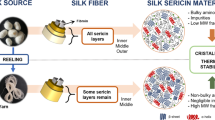Abstract
Resins were produced from artificial spider protein powder (53-100 μm particles) by hot-pressing at 100–180 °C and 30 MPa with 0–30 wt% added water. These were subjected to three-point bending, optical performance analysis, Fourier-transform infrared (FTIR)-attenuated total reflectance (ATR) spectroscopy, and crystallinity analysis by wide-angle X-ray scattering (WAXS). The resin produced with 30 wt% water and at lower temperature (120 °C) achieved the highest optical translucency, and its bending strength (∼144.6 MPa) and bending modulus (∼8.3 GPa) were comparable to those of high-performance plastics such as polyphenylene sulfide. Compared to silk from domestic silkworms, the high water uptake of this spider protein is attributed to its larger amount of hydrophilic amino acids. Spider protein resin showed slightly higher crystallinity after adding 30 wt% water during hot-pressing (∼39 % vs. ∼37 % without added water). Spectroscopic analyses also suggested that the addition of water promoted the formation of β-sheet (crystal region), supporting the crystallinity results.
Similar content being viewed by others
References
A. Rising, M. Widhe, J. Johansson, and M. Hedhammar, Cell. Mol. Life Sci., 68, 169 (2011).
B. Madsen, Z. Z. Shao, and F. Vollrath, Macromolecules, 24, 301 (1999).
H. Chung, T. Y. Kim, and S. Y. Lee, Cur. Opin. Biotechnol., 23, 957 (2012).
W. Yu, T. Kuzuya, S. Hirai, and Y. Tamada, Sen’i Gakkaishi, 68, 259 (2012).
A. Kaneko, Y. Tamada, S. Hirai, T. Kuzuya, and T. Hashimoto, Macromol. Mater. Eng., 297, 272 (2012).
H. A. Tuan, S. Hirai, T. Tamada, and S. Akioka, Mater. Sci. Eng. C, 97, 431 (2019).
Y. Cao and B. Wang, Int. J. Mol. Sci., 10, 1514 (2009).
J. Magoshi and S. Nakamura, J. Polym. Sci., Part B: Polym. Phys., 23, 227 (1985).
M. Tsukada, J. Polym. Sci.: Polym. Lett. Ed., 18, 501 (1980).
M. Tsukada, J. Polym. Sci., Part B: Polym. Phys., 24, 457 (1986).
X. Hu, D. Kaplan, and P. Cebe, Macromolecules, 39, 6161 (2006).
C. Xing, T. Munro, B. White, H. Ban, C. G. Copeland, and R. V. Lewis, Polymer (Guildf), 55, 4226 (2014).
N. Jaramillo-Quiceno, C. Álvarez-López, and A. Restrepo-Osorio, Procedia Eng., 200, 384 (2017).
X. Hu, K. Shmelev, L. Sun, E. S. Gil, S. H. Park, P. Cebe, and D. L. Kaplan, Biomacromolecules, 12, 1686 (2011).
K. Kotaka, T. Ishii, J. Ebara, R. Sato, and J. Noba, Patent, WO2017094722A1 (2017).
L. W. Jelinski, A. Blye, O. Liivak, C. Michal, G. Laverde, A. Seidel, N. Shah, and Z. Yang, Macromolecules, 24, 197 (1999).
N. A. Oktaviani, A. Matsugami, D. Malay, F. Hayashi, D. L. Kaplan, and K. Numata, Nat. Commun., 9, 2121 (2018).
J. Hosokawa, T. Endo, R. Kitagawa, and M. Nishiyama, Rep. Shikoku Nat. Ind. Res. Inst., 29, 79 (1998).
R. E. Marsh, R. B. Corey, and L. Pauling, Biochim. Biophys. Acta, 16, 1 (1955).
K. Yazawa, A. D. Malay, H. Masunaga, Y. Norma-Rashid, and K. Numata, Commun Mater, 1, 10 (2020).
Y. K. Lee and J. M. Powers, Dent. Mater., 23, 259 (2007).
J. Lee, H. Jung, J. Lee, D. Lim, K. Yang, J. Yi, and W. C. Song, Thin Solid Films, 516, 1634 (2008).
I. Saarikoski, M. Suvanto, and T. A. Pakkanen, Thin Solid Films, 516, 8278 (2008).
S. Meng, N. Sun, K. Su, F. Feng, S. Wang, D. Wang, X. Zhao, H. Zhou, and C. Chen, Polymer, 116, 89 (2017).
N. Hong, J. Zhan, X. Wang, A. A. Stec, T. R. Hull, H. Ge, W. Xing, L. Song, and Y. Hu, Compos. Part A, 64, 203 (2014).
O. M. Doğan, G. Bolayir, S. Keskin, A. Doğan, and B. Bek, J. Mater. Sci. — Mater. Med., 19, 2343 (2008).
H. A. Derazkola and M. Elyasi, J. Manuf. Processes, 35, 88 (2018).
X. Hao, G. Gai, F. Lu, X. Zhao, Y. Zhang, J. Liu, Y. Yang, D. Gui, and C. Nan, Polymer, 46, 3528 (2005).
Y. Yamamoto and M. Hashimoto, Wear, 257, 181 (2004).
Spiber Inc. and Technohama Co., Ltd., Japan Patent, WO2018043698 (2018).
X. Hu, X. Wang, J. Rnjak, A. S. Weiss, and D. L. Kaplan, Biomaterials, 31, 8121 (2010).
D. Xu, X. Shi, F. Thompson, W. S. Weber, Q. Mou, and J. L. Yarger, Int. J. Biol. Macromol., 81, 171 (2015).
T. Asakura, M. Okonogi, Y. Nakazawa, and K. Yamauchi, J. Am. Chem. Soc., 128, 6231 (2006).
E. S. Sashina, A. M. Bochek, N. P. Novoselov, and D. A. Kirichenko, Russ. Appl. Chem., 79, 869 (2006).
S. Miyata and N. Okui, Soc. Polym. Sci. Jpn., 30, 365 (1981).
D. J. Little and D. M. Kane, Opt. Soc., 19, 19182 (2011).
Y. Ohstuka, Soc. Rubber Sci. Technol. Jpn., 61, 805 (1988).
Acknowledgments
The research was supported by the ImPACT (Impulsing Paradigm Change through Disrupt Technologies) Program (2015-PM06-04-01). The authors would like to thank companies and research institutes that participated in the ImPACT Program. They also sincerely thank Spiber Inc. for providing the materials.
Author information
Authors and Affiliations
Corresponding author
Rights and permissions
About this article
Cite this article
Akioka, S., Hirai, S., Nakayama, Y. et al. Effects of Added Water on the Resinification Conditions, Bending Strength, Optical Performance, and Structural Properties of Artificial Spider Protein Resin Prepared by Hot-Pressing the Powder. Fibers Polym 23, 263–272 (2022). https://doi.org/10.1007/s12221-021-3038-7
Received:
Revised:
Accepted:
Published:
Issue Date:
DOI: https://doi.org/10.1007/s12221-021-3038-7




